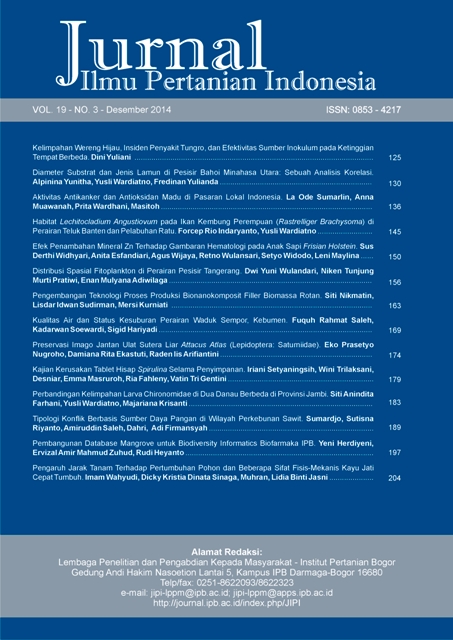Distribusi Spasial Fitoplankton di Perairan Pesisir Tangerang
Abstract
This study was conducted in describing the spatial distribution of phytoplankton in the coast of Tanggerang based on species composition and abundance. This study held on April and August 2013 in 10 sampling station. Sample survey method used to collect the data. Morisita Index of Dispersion used to describe the distribution pattern of phytoplankton and Bray-Curtis Index used to describe the similarity of sampling station based on its abundances of phytoplankton. Based on result of the study, the phytoplankton in the coast of Tangerang consist of three classes, which is Bacillariophyceae (24 genera), Dinophyceae (3 genera), and Cyanophyceae (2 genera). The result shows that the highest composition and abundance is from the species of Bacillariophyceae. The distribution pattern of phytoplankton is group distribution. The distribution of species of phytoplankton and its abundance is different even the sampling station is near each other and environmental parameters that influence.
Downloads
References
Alianto. 2011. Kajian dinamika pertumbuhan fitoplankton dan keterkaitannya dengan variabilitas intensitas cahaya matahari dan nutrient inorganic terlarut di perairan Teluk Banten. [Disertasi]. Bogor (ID): Institut Pertanian Bogor.
Ariyani F, Sue RA. 2009. Kondisi Perairan di Sekitar Pangkalan Pendaratan Ikan (PPI) Kronjo, Tangerang, Banten. [Penelitian Terapan]. Jakarta (ID): Sekolah Tinggi Perikanan Jakarta.
Badylak S, Philips ES. 2004. Spatial and temporal patterns of phytoplankton composition in a subtropical coastal lagoon, the Indian River Lagoon, Florida, USA. Journal of Plankton Research. 26(10): 1229-1247.
Brower JE, Zar JH, Von Ende CN. 1990. Field and Laboratory methods for General Ecology, 3rd edition. Wm.C. Brown Co. Publisher, Dubuque lowa (US).
Chandy JP, Al-Tisan I, Munshi HA, El Reheim HA. 1991. Marine phytoplankton: A study on seasonal abundance and distribution in Al-Jubail. Issued as Technical Report No. SWCC (RDC) 17 in December, 1991.
Clark JR. 1996. Coastal Zone Management Handbook. Lewis Publisers, Boca Raton, Florida (US).
Davis CC. 1955. The Marine and Freshwater Plankton. Michigan State University Press, Michigan (US).
Haumahu S. 2004. Distribusi spasial fitoplankton di Teluk Ambon bagian dalam. Ichtyos. 3(2): 91-98.
Kennish MJ. 1990. Ecology of estuary. Volume II. Biological Aspect. CRC press, Florida (US).
Liu H, Suzuki K, Saito H. 2004. Community Structure and Dynamics of Phytoplankton in the Western Subarctic Pacific Ocean: A Synthesis. Journal of Oceanography. 60(1): 119-137.
Mackey DJ, Blanchot J, Higgins HW, Neveux J. 2002. Phytoplankton abundances and community structure in the equatorial Pacific. Deep-Sea Research II. 49: 2561-2582.
Madhav VG, Kondalarao B. 2004. Distribution of phytoplankton in the coastal waters of east coast of India. Indian Journal of Marine Science. 33(3): 262-268.
Mochizuki MN, Saito M, Imai K, Nojiri Y. 2002. Seasonal changes in nutrients, chlorophyll-a, and the phytoplankton assemblage of the western subarctic gyre in the Pacific Ocean. Deep Sea Research. 49(24): 5421-5439.
Newell GE, Newell RC. 1977. Marine Plankton; a practical guide. Hutchinson co, London (GB).
Nontji A. 2007. Laut nusantara. Djambatan, Jakarta (ID).
Nybakken JW. 2005. Marine biology: An ecological approach 6th ed. Pearson Education, San Francisco (US).
Odum EP. 1971. Fundamentals of ecology. Third Ed. W.B. Saunders Company, Philadelphia (US).
Raymont JEG. 1984. Plankton dan produktivitas bahari. Alih bahasa oleh Koesobiono. Pasca Sarjana. Institut Pertanian Bogor, Bogor (ID).
Rice EW, Baird RB, Eaton AD, Clesceri LS. 2012. APHA (American Public Health Association): Standard Method for The Examination of Water and Wastewater 22th ed. Washington DC (US): AWWA (American Water Works Association) and WEF (Water Environment Federation).
Riyadi AS, Itai T, Isobe T, Ilyas M, Sudaryanto A, Setiawan I, Tahahashi S. 2012. Spatial Profile of Trace Elements in Marine Sediments from Jakarta Bay, Indonesia. Interdisciplinary Studies on Environmental Chemistry-Environmental Pollution and Ecotoxicology, TERRAPUB. 141-150.
Simon N, Cras AL, Foulon E, Lemee R. 2009. Diversity and evolution of marine phytoplankton. Comptes Rendus Biologies. 332(2): 159-170.
Skaloud P, Rezacova M. 2004. Spatial distribution phytoplankton in the eastern part of the North Sea. Departemen of Phycology. Institute of Biology. University of Copenhagen, Kobenhavn (DK).
Tomas CR. 1997. Identifying marine phytoplankton. Academic Press, California (US).
Yamaji I. 1979. Illustration of the marine plankton of Japan. Hoikusha Publishing Co. Ltd, Osaka (JP).
Yoshioka PM. 2008. Misidentification of the Bray-Curtis similarity index. Marine Ecology Progress Series. 368: 309-310.
Yuliana. 2012. Implikasi perubahan ketersediaan nutrien terhadap perkembangan pesat (blooming) fitoplankton di perairan teluk Jakarta. [Disertasi]. Bogor (ID): Institut Pertanian Bogor.
This journal is published under the terms of the Creative Commons Attribution-NonCommercial 4.0 International License. Authors who publish with this journal agree to the following terms: Authors retain copyright and grant the journal right of first publication with the work simultaneously licensed under a Creative Commons Attribution-NonCommercial 4.0 International License. Attribution — You must give appropriate credit, provide a link to the license, and indicate if changes were made. You may do so in any reasonable manner, but not in any way that suggests the licensor endorses you or your use. NonCommercial — You may not use the material for commercial purposes.



















